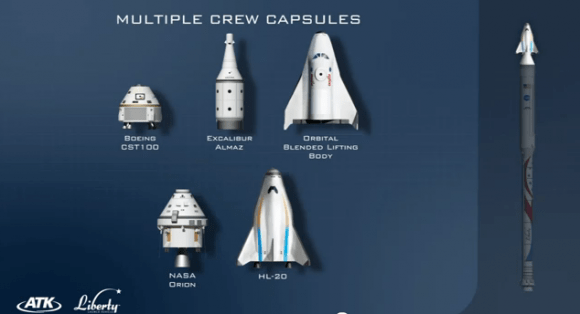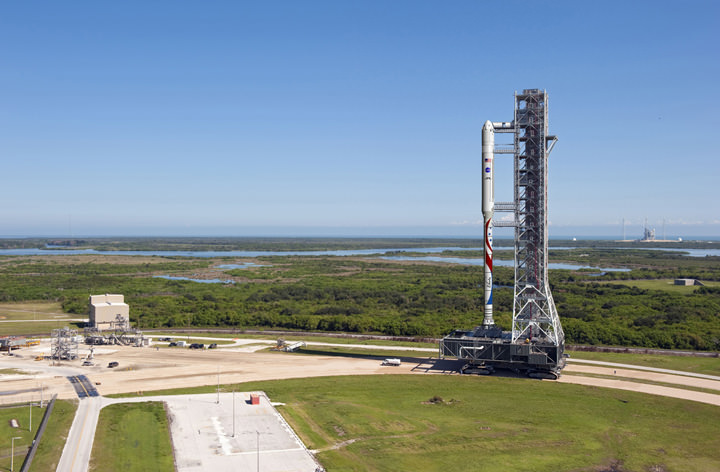[/caption]CAPE CANAVERAL, Fla – Liberty has wings. That is to say that the launch vehicle proposed by Alliant Techsystems or ATK as they are more commonly known has been given the green light by NASA – albeit unfunded – as part of a Space Act Agreement. The announcement was made at the Kennedy Space Center press site’s auditorium in Florida Tuesday at 3 p.m. EDT. With ATK’s addition – the fleet of potential spacecraft and launch vehicles could mean that the space agency will not only be able to return to human space flight operations sooner – but with a more diverse range of vehicles to do so as well.
The proposal to use the Liberty launch vehicle, which is comprised of a five-segment solid rocket booster (similar to the four-segment SRB utilized during the shuttle program) and an Ariane V upper stage could reduce the human space flight “gap” that NASA is currently experiencing. As the company that produces the Ariane V, Astrium, is a European firm this deal also works to fulfill the White House’s wishes that space endeavors be conducted on an international level. More importantly – ATK has stated that they could be ready to launch as early as 2015.

After the Ares I launcher was scrapped along with most of the rest of the Constellation Program by the Obama Administration ATK looked into ways to preserve the project. ATK was one of the first to see the commercial crewed writing on the wall and went to work revamping the project. With a far lower cost, international partner and a new paint job – Liberty was born.
The rationale behind why the Liberty announcement was made at KSC – was highlighted by ATK’s Vice-President for Test and Research Operations, Kent Rominger.
“We want to launch Liberty from Kennedy Space Center,” said Rominger. “Our concept of operations is based around KSC assets such as the Vehicle Assembly Building (VAB). Liberty will be processed much in the same manner as the space shuttle was – so KSC is central to Liberty’s operations.”
With the inclusion of Liberty – most elements of the Constellation Program are back in place. Liberty could potentially be the launch vehicle that sends astronauts to orbits, the Space Launch System which closely resembles the Ares V is currently in development, the Orion Multi-Purpose Crew Vehicle is still in place as is the Lunar Electric Rover (although it has been renamed the “Space Exploration Vehicle”). The only element that has yet to be resurrected is the over-arching ‘Vision for Space Exploration’ – which directed NASA to go to the “Moon, Mars and Beyond.”
If all works out with NASA’s Commercial Crew Program NASA could see a problem that faced the space agency in the wake of the Challenger and Columbia accidents – erased. After the loss of each of the orbiters NASA was unable to launch astronauts to orbit for a period of roughly two years. With Liberty and man-rated versions of United Launch Alliance’s Atlas and SpaceX’s Falcon 9 rocket – if one of these launch vehicles experienced an in-flight anomaly NASA could simply switch to another launcher while any problem with another rocket is being investigated. This of course depends on whether-or-not NASA receives the funding to accomplish this.



I’m not to thrilled with this rocket. The use of solid rocket boosters as the first stage was a mistake with the Ares-1, and it’s a mistake with this rocket too. These legacy solid rocket boosters are inherently unsafe due to their “fire and forget” design (can’t be safely shut down after ignition, can’t be restarted upon failure).
Why would anyone create a rocket using a product that has well known design issues? Of course the answer here is that ATK manufactures those flawed boosters and no one else does. If it can create a situation where NASA is reliant on this type of SRB, it will have a monopoly like it did with the shuttle.
Sneaky.
No one is thrilled with this rocket. An unfunded Space Act agreement without Memoranda of Understanding from any of the crew vehicle providers sums up all the interest ATK/EADS have manged to attract to their CCDev2 rejected launcher. NASA chips in two dozen full time staff and access to launch facilities already in place and that’s it.
At least this a no longer the multi billion dollar tax payer disgrace called Ares 1, so cancellation of CxP has had an upside. Just the cost of the custom crawler/mobile lunch platform alone for this launcher far exceeds the total development cost of the SpaceX Falcon 9 which has already flown.
The operating cost of the ATK/EADS launcher are unknown because they go up or down with flight rate which, at the moment, is zero suggesting it may be a little premature to title this story “Launcher [has been] Added to NASA’s Commercial Crewed Roster“.
I agree that far reaching space endeavors could be based on international cooperation but for our launch vehicles the equipment should be American made.
“…inherently unsafe due to their “fire and forget” design (can’t be safely shut down after ignition, can’t be restarted upon failure).”
They may be ‘fire and forget’ – but SRB’s are many times more reliable liquid fueled rockets. Liquid fueled engines are immensely complex designs, running with huge numbers of highly-stressed moving parts, all needing impeccable maintenance standards and assembly line tolerances and QC. Hell – the fluid dynamics in some parts of LFEs is so poorly understood that designing impellers and compressors for turbopumps is often more art, with a liberal dash of trial and error thrown in, than science. SRBs are also extremely unlikely to fail in such a way as you’d want to restart them – they won’t just stop burning mid-flight unless the QC is impossibly bad. As for shutting them down – no you can’t. But if you have a basic launch abort/eject system on the end, this somewhat mitigates any minimal existing risk.
Yes – the challenger disaster was caused by poor SRB design, but that was in the very early days of SRBs of that scale. Compared to LFEs, SRBs are simplicity itself and almost completely understood from a physics and engineering point of view. It is most certainly the safest and most reliable aspect of shuttle launches these days…
Shuttle launches these days are shut down – due to SRB reliability problems, among other reasons.
Shuttle launches these days are shut down – due to SRB reliability problems, among other reasons.
Shuttle launches these days are shut down – due to SRB reliability problems, among other reasons.
Can I ask why the “sort by popular now” ? I would be surprised if a large percentage of your readers are Gen Z. It might sound churlish, but we think linearly !
I always set the “sort by” to “oldest first” before reading any comments and wish there was some way of permanantly setting my Disqus preferences to this. I want comments to appear in the order in which they were posted, not some arbitrary sequence based on I know nor care not what.
It looks like Ares.
Since this is a repeat of the unaffordable Constellation program, we are faced with two options, modulo the extra years to flight:
– Either this is unaffordable too, and Congress and NASA has saddled themselves with another failure.
– Or the initial program was over-prized pork, and the politicians and companies have been forced to settle for the lesser amount of skin to fleece.
But it _was_ resurrected, as the current “vision for NASA space exploration“:
“A set of stepping-stone achievements in space that will take us further and faster into space, allowing us to reach a range of destinations including lunar orbit, Lagrange points, near-Earth asteroids, and the moons of Mars, and eventually Mars itself.”
[Even the “Beyond” part is there too: “other destinations”.]
They ( srbs ) become unstable after a few years.
The Russians used to use them for their nukes.